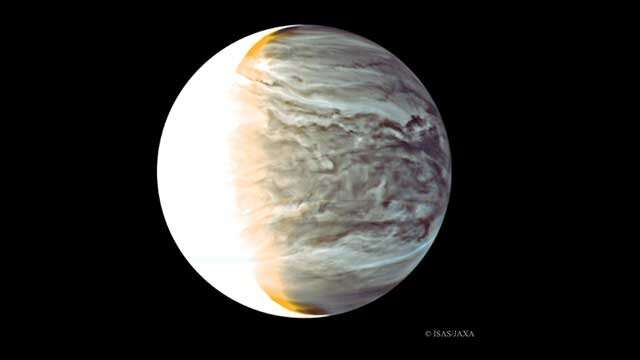Night on Venus in Infrared from Orbiting Akatsuki. Credit: ISAS, JAXA
New data analysis has found that the sunlight filtering through Venus' clouds could support Earth-like photosynthesis in the cloud layers and that chemical conditions are potentially amenable to the growth of microorganisms.
Biochemistry Professor Rakesh Mogul is the lead author of the study, Potential for Phototrophy in Venus' Clouds, published online this week in the October 2021 special issue of Astrobiology, focused on the possible suitability of Venus' clouds for microbial life, and constraints that may prohibit life.
According to Mogul and his team, which includes Michael Pasillas ('21, M.S.), photosynthesis could occur round-the-clock in Venus' clouds with the middle and lower clouds receiving solar energy similar to the Earth's surface. Much like on Earth, hypothetical phototrophs in Venus' clouds would have access to solar energy during the day.
In a fascinating twist, the team found that photosynthesis may continue through the night due to thermal or infrared energy originating from the surface and the atmosphere. In this habitat, light energy would be available from both above and below the clouds, which could provide photosynthetic microorganisms ample opportunities to diversify across the cloud layers. Both the solar and thermal radiation in Venus' clouds possess wavelengths of light that can be absorbed by the photosynthetic pigments found on Earth.
The study also found that after filtering through the Venusian atmosphere, scattering and absorption scrubs the sunlight of much of the ultraviolet radiation (UV) that is harmful to life, providing a benefit like Earth's ozone layer.
Yeon Joo Lee, a co-author of the study, used a radiative transfer model to show that the present-day middle and lower cloud layers above Venus receive significantly less UV, 80–90% less flux in the UV-A when compared to Earth's surface, and are essentially depleted of radiation in the UV-B and UV-C, which represent the most harmful components of the UV.
To gauge the nighttime photosynthetic potential via Venus' thermal energy, Mogul and his team compared the photon fluxes rising from Venus' hot atmosphere and surface to the photon fluxes measured within low-light phototrophic habitats on Earth—hydrothermal vents in the East Pacific Rise, where geothermal emissions are reported to support phototrophy at depths of 2400 meters, and the Black Sea, where solar powered phototrophs are found at depths of 120 meters. These comparisons showed that photon fluxes from Venus' atmosphere and surface exceed the fluxes measured in these low-light phototrophic environments on Earth.
While a recent report by Hallsworth et al. 2021, concluded that Venus' clouds were too dry to support terrestrial life, Mogul and his team found that the chemical conditions of Venus' clouds could be partly composed of neutralized forms of sulfuric acid, such as ammonium bisulfate. These chemical conditions would exhibit dramatically higher water activities when compared to Hallsworth's calculations and much lower acidities when compared to current models for Venus.
"Our study provides tangible support for the potential for phototrophy and/or chemotrophy by microorganisms in Venus' clouds," said Mogul. "The acidity and water activity levels potentially fall within an acceptable range for microbial growth on Earth, while the constant illumination with limited UV suggests that Venus' clouds could be hospitable for life. We believe that Venus' clouds would make a great target for habitability or life detection missions, like those currently planned for Mars and Europa."
More information: Rakesh Mogul et al, Potential for Phototrophy in Venus' Clouds, Astrobiology (2021). DOI: 10.1089/ast.2021.0032
Journal information: Astrobiology
Provided by California State Polytechnic University
























